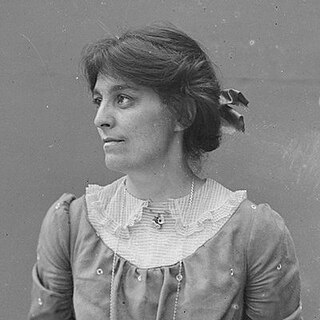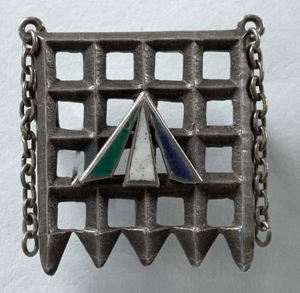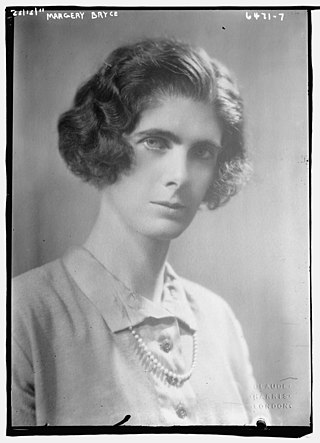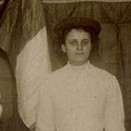
The Women's Social and Political Union (WSPU) was a women-only political movement and leading militant organisation campaigning for women's suffrage in the United Kingdom from 1903 to 1918. Known from 1906 as the suffragettes, its membership and policies were tightly controlled by Emmeline Pankhurst and her daughters Christabel and Sylvia; Sylvia was eventually expelled.

Emmeline Pethick-Lawrence, Baroness Pethick-Lawrence was a British women's rights activist and suffragette.

The United Procession of Women, or Mud March as it became known, was a peaceful demonstration in London on 9 February 1907 organised by the National Union of Women's Suffrage Societies (NUWSS) in which more than 3,000 women marched from Hyde Park Corner to the Strand in support of women's suffrage. Women from all classes participated in what was the largest public demonstration supporting women's suffrage seen until then. It acquired the name "Mud March" from the day's weather since incessant heavy rain left the marchers drenched and mud-spattered.

Marion Wallace Dunlop was a Scottish artist and author. She was the first and one of the most well known British suffragettes to go on hunger strike, on 5 July 1909, after being arrested in July 1909 for militancy. She said she would not take any food unless she was treated as a political prisoner instead of as a common criminal. Wallace Dunlop's mode of protest influenced suffragettes after her and other leaders like M. K. Gandhi and James Connolly, who also used fasting to protest British rule. She was at the centre of the Women's Social and Political Union and designed processions and banners for them.

A suffragette was a member of an activist women's organisation in the early 20th century who, under the banner "Votes for Women", fought for the right to vote in public elections in the United Kingdom. The term refers in particular to members of the British Women's Social and Political Union (WSPU), a women-only movement founded in 1903 by Emmeline Pankhurst, which engaged in direct action and civil disobedience. In 1906, a reporter writing in the Daily Mail coined the term suffragette for the WSPU, derived from suffragist, in order to belittle the women advocating women's suffrage. The militants embraced the new name, even adopting it for use as the title of the newspaper published by the WSPU.

Jessica "Jessie" Kenney (1887–1985) was an English suffragette who was jailed for assaulting the Prime Minister and Home Secretary in a protest to gain suffrage for women in the UK. Details of a bombing campaign to support their cause were discovered by the authorities in her flat when Kenney was sent abroad to convalesce. She later trained as a wireless operator but worked as a stewardess.

Mabel Kate Tuke born Mabel Kate Lear was a British suffragette known for her role of honorary secretary of the militant Women's Social and Political Union.

Florence Eliza Haig (1856–1952) was a Scottish artist and suffragette who was decorated for imprisonments and hunger strikes.

Lucy Minnie Baldock was a British suffragette. Along with Annie Kenney, she co-founded the first branch in London of the Women's Social and Political Union.
Sara Jessie Stephenson (1873–1966) was a British suffragette and a member of the WSPU who organised census boycott in Manchester.

Louise Mary Eates was a British suffragette, chair of Kensington Women's Social and Political Union and a women's education activist.

Louie Cullen was a British suffragette and hunger striker who emigrated to Australia to continue her feminist activism. She was imprisoned for her activist work, and was awarded a Holloway brooch.

The Holloway brooch was presented by the Women's Social and Political Union (WPSU) to women who had been imprisoned at Holloway Prison for militant suffragette activity. It is also referred to as the "Portcullis badge", the "Holloway Prison brooch" and the "Victoria Cross of the Union".

Marjery Bryce was a British suffragette and actor, rode dressed as Joan of Arc in WSPU parades in support of votes for women.

Helen Millar Pethick-Lawrence, Baroness Pethick-Lawrence was a suffragette and pharmacist.
Patricia Woodlock was a British artist and suffragette who was imprisoned seven times, including serving the longest suffragette prison sentence in 1908 ; she was awarded a Women's Social and Political Union (WSPU) Hunger Strike Medal for Valour. Her harsh sentence caused outrage among supporters and inspired others to join the protests. Her release was celebrated in Liverpool and London and drawn as a dreadnought warship, on the cover of the WSPU Votes for Women newsletter.

The WSPU Holloway Banner is a suffragette banner designed by Scottish artist Ann Macbeth.

Dorothy Hartopp Radcliffe was a British suffragette, member of the WSPU, and later a Carmelite nun.
Irene Margaret Dallas (1883–1971) was a suffragette activist, speaker and organiser who held leadership roles in the WSPU; she was arrested and imprisoned with a group who tried to gain access to 10 Downing Street.
Elizabeth Ellen (Beth) Hesmondhalgh, active 1907 –1914, began working around 1885 as a cotton spinner in Preston, and became a British suffragette, imprisoned twice for militant protesting on behalf of women's franchise, and awarded the Women's Social and Political Union (WSPU) Hunger Strike Medal for valour.

















